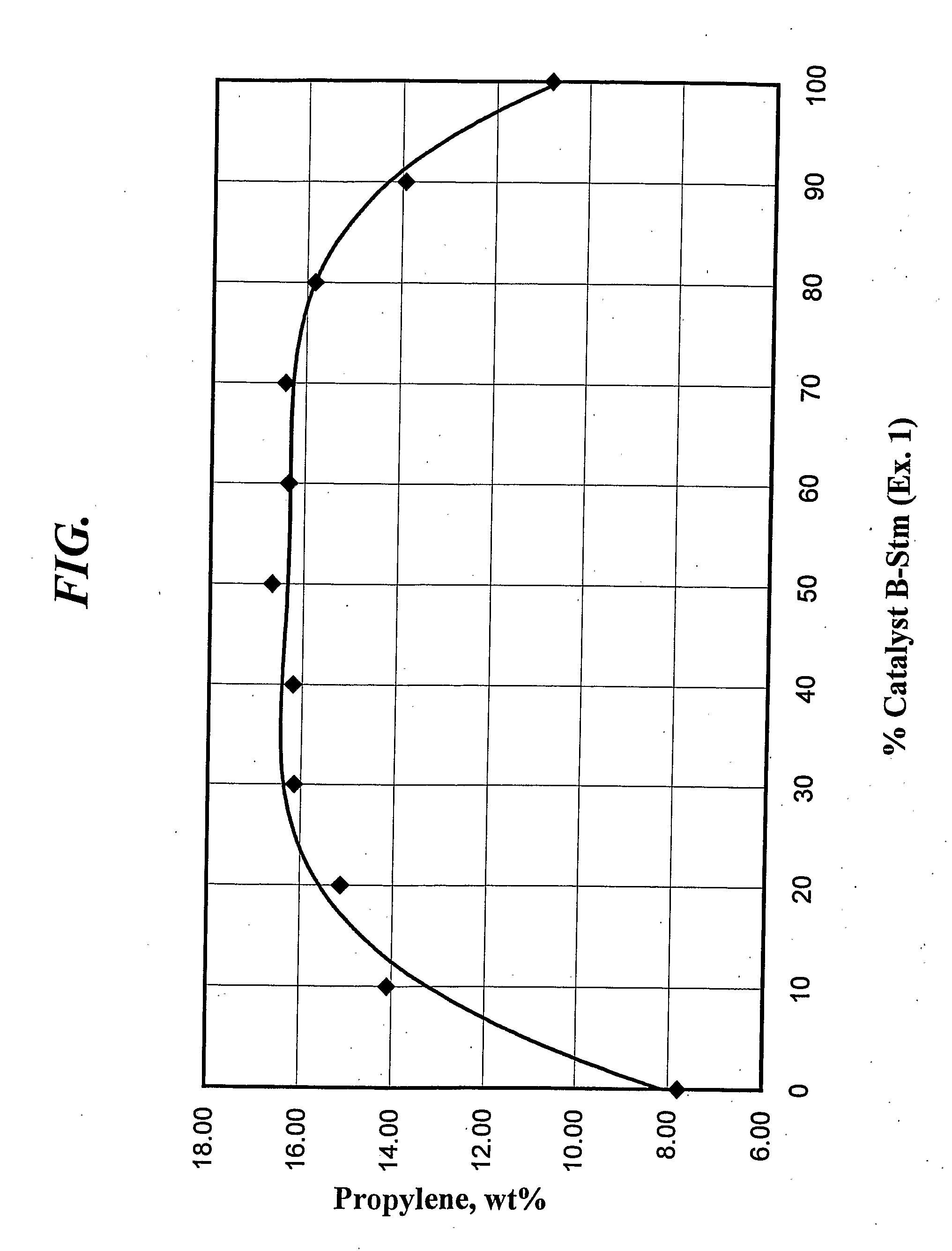Catalyst for Light Olefins and Lpg in Fludized Catalytic Units
a technology of fludized catalytic units and light olefins, which is applied in the direction of catalyst activation/preparation, physical/chemical process catalysts, hydrocarbon oil treatment products, etc., to achieve the effect of enhancing olefin yield
- Summary
- Abstract
- Description
- Claims
- Application Information
AI Technical Summary
Benefits of technology
Problems solved by technology
Method used
Image
Examples
example 1
The Invention
[0123] Catalyst A, containing 45% USY zeolite, 33% clay and 22% by weight silica sol binder was prepared as follows. An aqueous slurry of USY (4 wt % Na2O) was blended with Natka clay and then milled in a Drais mill. Silica sol binder was added to the milled slurry and mixed well before spray drying in a Bowen spray dryer. The silica sol binder was prepared from sodium silicate and acid alum. The resulting spray dried product was washed with ammonium sulfate solution, followed by water to give a catalyst with a Na2O level of less than 0.45 wt %. The product was steam deactivated in a fluidized bed reactor for 4 hours at 816° C. in a 100% steam at atmospheric pressure. The deactivated catalyst is designated Catalyst A-Stm.
[0124] Catalyst B, containing 40% ZSM-5, was prepared as described in US 2002 / 0049133. The catalyst was steam deactivated in a fluidized bed reactor for 4 hours at 816° C. in a 100% steam atmosphere. The deactivated catalyst is designated Catalyst B-S...
example 2
Matrix Surface Area
[0128] Catalyst C, containing 55% USY, 5% Boehmite alumina and 20% alumina sol binder, 2% RE2O3 on zeolite and remainder clay, was prepared as follows. An aqueous slurry of 9.8 kg USY zeolite (1% Na2O, 34% solids) was blended with 367 g of rare earth salt solution (27% RE2O3), 300 g (dry basis) of a particulate Boehmite alumina, 1200 g Natka clay (dry basis) and 5.2 kg of aluminum hydrochlorol (23% Al2O3). The slurry was mixed well and then milled in a Drais mill. The milled catalyst slurry was spray dried in a Bowen spray drier. The spray-dried product was calcined for 40 minutes at 400° C. The calcined product was then washed using conventional techniques to lower the Na2O level. The catalyst was steamed in a fluidized bed reactor for 4 hours at 816° C. in a 100% steam atmosphere. The deactivated Catalyst C was combined in a 1:1 ratio with Catalyst B-Stm. The catalyst combination is designated Catalyst CB-Stm. The surface area of Catalyst CB-Stm is shown in Tab...
example 3
[0129] Catalyst D, containing 55% USY, 20% alumina sol binder, 5% Boehmite alumina and 2% RE2O3 on zeolite was prepared as follows. An aqueous slurry of USY (1% Na2O on zeolite) was blended with aluminum chlorohydrol, Boehmite alumina, rare earth salt, and Natka clay. The slurry was mixed well and then milled in a Drais mill. The milled catalyst slurry was spray dried in a Bowen spray drier. The spray-dried product was calcined for 40 minutes at 593° C. The catalyst was steamed in a fluidized bed reactor for 4 hours at 816° C. in a 100% steam atmosphere. The deactivated Catalyst D was combined in a 1:1 ratio with Catalyst B-Stm. The catalyst combination is designated Catalyst DB-Stm. The surface area of Catalyst DB-Stm is shown in Table 4.
PUM
| Property | Measurement | Unit |
|---|---|---|
| weight ratio | aaaaa | aaaaa |
| weight percent | aaaaa | aaaaa |
| weight percent | aaaaa | aaaaa |
Abstract
Description
Claims
Application Information
 Login to View More
Login to View More - R&D
- Intellectual Property
- Life Sciences
- Materials
- Tech Scout
- Unparalleled Data Quality
- Higher Quality Content
- 60% Fewer Hallucinations
Browse by: Latest US Patents, China's latest patents, Technical Efficacy Thesaurus, Application Domain, Technology Topic, Popular Technical Reports.
© 2025 PatSnap. All rights reserved.Legal|Privacy policy|Modern Slavery Act Transparency Statement|Sitemap|About US| Contact US: help@patsnap.com



